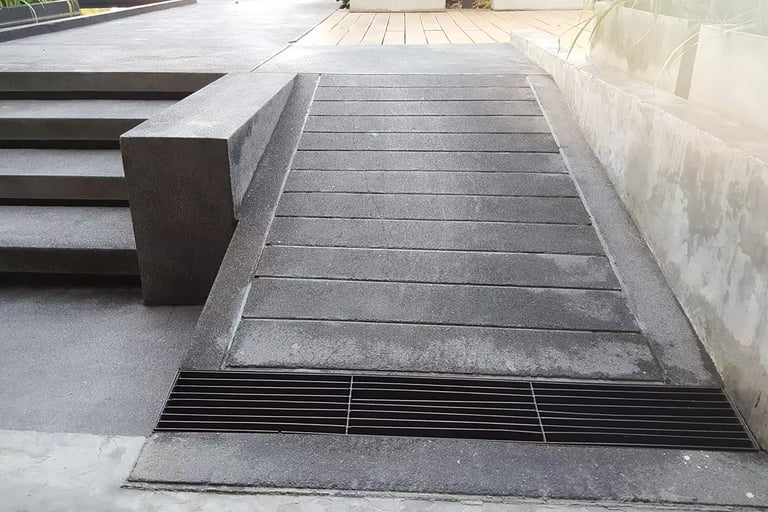CALL US TODAY! → (863) 348-2601 / (863) 257-1120
The Essential Guide to Concrete Ramps: Enhancing Accessibility in Residential and Commercial Spaces
Safe, smooth, and accessible—see how our ramps elevate your space.
7/26/20254 min read


Understanding the Importance of Concrete Ramps for Accessibility
Concrete ramps play a pivotal role in enhancing accessibility for individuals with mobility challenges. These structures facilitate seamless movement in various environments, making them crucial for both residential and commercial spaces. In residential settings, concrete ramps provide essential access to homes for individuals using wheelchairs, walkers, or other mobility aids. They serve as a key component in ensuring that the living environment is inclusive, allowing individuals of varying abilities to enter and navigate their homes independently.
In commercial environments, the significance of concrete ramps is further amplified due to the diverse clientele that businesses serve. Compliance with the Americans with Disabilities Act (ADA) is not only a legal requirement but also a moral obligation. Ramps must be designed to meet specific slope ratios and safety guidelines to ensure that all individuals can access facilities safely. Businesses that prioritize accessibility through the installation of well-designed concrete ramps demonstrate their commitment to inclusivity and build a positive reputation among consumers.
Research highlights the impact of effective ramp design on the independence and mobility of people with disabilities. For instance, a study conducted by the National Institute on Disability, Independent Living, and Rehabilitation Research showed that properly designed ramps significantly reduce barriers faced by individuals in public spaces. Furthermore, statistics reveal that when businesses equip their premises with accessible features such as ramps, they often experience an increase in customer satisfaction and, subsequently, a boost in revenue. Ramps not only facilitate physical mobility but also symbolize societal progress toward inclusive spaces.
As we advance toward a more equitable society, the creation and implementation of concrete ramps become increasingly critical. By ensuring reliable and safe access through these essential structures, we foster an environment where individuals with disabilities can thrive, enhancing their overall quality of life and promoting independence.
Designing Concrete Ramps: Key Features and Considerations
When designing concrete ramps for both residential and commercial spaces, several technical aspects must be addressed to ensure safety and usability. The most critical element is the slope ratio, which should ideally not exceed 1:12 for wheelchair accessibility. This ratio permits individuals with mobility impairments to ascend or descend the ramp with ease. Such standardized slopes are crucial, as steeper ramps can pose significant challenges to users, potentially leading to accidents.
Width is another vital consideration. A ramp should be at least 36 inches wide to accommodate various mobility devices. This width facilitates the safe passage of wheelchairs, walkers, and scooters, allowing users adequate space to maneuver. If the ramp serves a higher traffic area, a wider design may be necessary to prevent congestion and promote smooth movement.
Incorporating handrails is essential for enhancing safety. Handrails should be installed on both sides of the ramp, positioned between 34 and 38 inches above the ramp surface. These features provide users with stability and support, especially during inclines and declines. Apart from handrails, the surface texture of the ramp also plays a crucial role in user safety. The ramp’s surface should be sufficiently textured to prevent slips and falls, particularly in rainy or icy conditions.
Adhering to local codes and regulations is paramount in ramp design. Compliance with the Americans with Disabilities Act (ADA) is necessary to ensure that ramps are functional and accessible for individuals with disabilities. These standards outline specific requirements regarding slope, width, railings, and surface materials. By following these guidelines, designers can create concrete ramps that serve their purpose effectively, fostering inclusivity in both residential and commercial environments.
Safety Considerations for Concrete Ramp Construction
Safety is paramount in the construction of concrete ramps, as these structures serve a crucial role in providing accessibility for individuals with mobility challenges. Implementing stringent safety standards during construction can mitigate risks associated with poorly designed or constructed ramps, significantly reducing incidents of slips and falls. A well-designed ramp should incorporate surface materials that are specifically chosen for their anti-slip properties. Textured finishes, aggregate surfaces, or treated options can enhance grip, thereby offering better traction, particularly in wet or inclement weather.
Another vital consideration in ramp safety is proper drainage. Impropriately designed ramps may lead to water pooling, presenting a serious slip hazard. Establishing adequate drainage systems to redirect water away from the ramp surface is essential. This could include designing the ramp with a slight slope for effective drainage or incorporating drainage channels along the sides to divert water. It is also important to maintain clear surfaces free from debris, ice, or other obstacles that could compromise the safety of users.
Routine maintenance plays a significant role in ensuring long-term safety for concrete ramps. Regular inspections should identify any cracks, structural weaknesses, or wear that could lead to safety concerns. Timely repairs and resurfacing are crucial to prevent deterioration that might affect the ramp's function and safety. Additionally, assessing the frequency of the ramp's use and the anticipated weight load can help ascertain the necessary design specifications. By tailoring the design to accommodate varying levels of traffic and weight, safety can be reinforced for all users, from pedestrians to those using mobility devices.
The Impact of Quality Concrete Ramps on Comfort and Mobility
Quality concrete ramps play a pivotal role in enhancing both comfort and mobility for individuals with disabilities. When designed and constructed with durable materials, these ramps not only meet safety standards but also significantly improve the user experience. The primary focus of any ramp should be to provide seamless entry and exit points, thereby facilitating independence for those with mobility challenges.
Investing in a high-quality concrete ramp ensures that the surface is smooth and sturdy, minimizing the risk of slips or falls. This is particularly vital for individuals using wheelchairs, walkers, or crutches. An expertly installed ramp considers appropriate slope ratios, which help in reducing the strain on users. Furthermore, the durability of high-grade materials means less frequent repairs, ultimately offering a long-term solution to accessibility issues.
Real-life testimonials illustrate the profound impact these ramps can have. For instance, a mother shared her experience of witnessing her son confidently navigate their home using a newly installed concrete ramp. The enhanced mobility not only improved his daily routine but also enriched family interactions, fostering a sense of inclusion. Another individual recounted how minor modifications to their business entrance via a quality ramp transformed the customer experience, attracting more patrons who valued the accessible entry.
Besides physical improvements, there are significant psychological benefits associated with quality ramps. Enhanced comfort translates to greater autonomy and self-esteem for users, as they feel empowered to move freely without relying heavily on assistance. Consequently, investing in well-designed concrete ramps is not merely about compliance with accessibility standards; it represents a commitment to improving the lives of individuals with disabilities by fostering mobility and independence.
Follow Us On Social Media
Contacts
Subscribe To Our Newsletter
Copyright © 2025 Los Brothers 1 Corp – "2 Brothers. 1 Strong Foundation!"
Fernando: (863) 348-2601
Rodrigo: (863) 257-1120
Hours
24/7 – We’re available day and night for your concrete needs.


